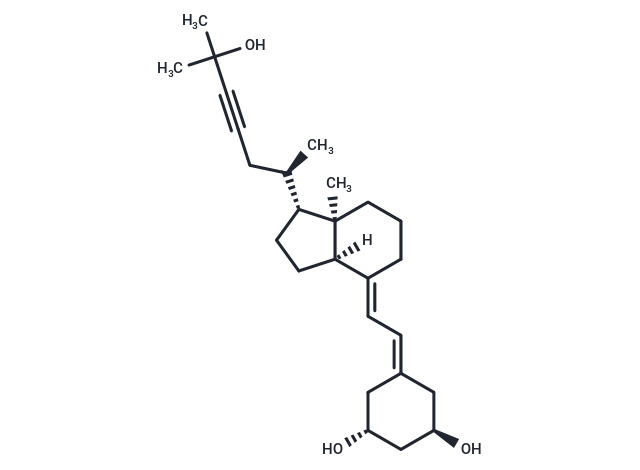Shopping Cart
Remove All Your shopping cart is currently empty
Your shopping cart is currently empty
Inecalcitol is a unique vitamin D3 analog that induces apoptosis and has anticancer activity. It is an orally active vitamin D receptor agonist with a Kd of 0.53 nM.

| Pack Size | Price | USA Warehouse | Global Warehouse | Quantity |
|---|---|---|---|---|
| 1 mg | $45 | In Stock | In Stock | |
| 5 mg | $106 | In Stock | In Stock | |
| 10 mg | $179 | - | In Stock | |
| 25 mg | $413 | - | In Stock | |
| 50 mg | Preferential | - | In Stock | |
| 1 mL x 10 mM (in DMSO) | $128 | - | In Stock |
| Description | Inecalcitol is a unique vitamin D3 analog that induces apoptosis and has anticancer activity. It is an orally active vitamin D receptor agonist with a Kd of 0.53 nM. |
| Targets&IC50 | Vitamin D3:0.53 nM(Kd) |
| In vitro | METHODS: SCC cells were treated with Inecalcitol (TX 522) (0.0008, 0.003, 0.012, 0.05, 0.2, 0.8, 3.2, 12.5 nM, 48 hours) and cell viability was measured by MTT assay. RESULTS Inecalcitol inhibited the growth of SCC cells in a dose-dependent manner with an IC50 of 0.38 nM. [1] METHODS: SCC cells were treated with Inecalcitol (TX 522) (1,10 nM), and Western Blot analysis was used to investigate the mechanism of inecalcitol-induced apoptosis. RESULTS Inecalcitol-treated SCC cells resulted in increased activity of caspase 8, 10, and 3, indicating that inecalcitol promotes apoptosis by activating the extrinsic pathway mediated by caspase 8/10 and caspase 3. [1] |
| In vivo | METHODS: Inecalcitol (TX 522) (1.3 mg/kg, intraperitoneal injection, 3 times a week) was used to treat mice bearing LNCaP cell tumor xenografts. Tumor size was measured and calculated, and blood was collected to measure serum calcium levels. RESULTS Inecalcitol-treated mice bearing tumor xenografts had a significant reduction in tumor size. The half-life of plasma Inecalcitol was 18.3 minutes. [2] |
| Synonyms | TX-522, TX522, TX 522 |
| Molecular Weight | 400.59 |
| Formula | C26H40O3 |
| Cas No. | 163217-09-2 |
| Smiles | [H][C@]12CC[C@H]([C@H](C)CC#CC(C)(C)O)[C@@]1(C)CCC\C2=C/C=C1C[C@@H](O)C[C@H](O)C1 |
| Relative Density. | 1.31g/cm3 |
| Storage | Powder: -20°C for 3 years | In solvent: -80°C for 1 year | Shipping with blue ice/Shipping at ambient temperature. | |||||||||||||||||||||||||||||||||||
| Solubility Information | DMSO: 55 mg/mL (137.3 mM), Sonication is recommended. | |||||||||||||||||||||||||||||||||||
Solution Preparation Table | ||||||||||||||||||||||||||||||||||||
DMSO
| ||||||||||||||||||||||||||||||||||||
| Size | Quantity | Unit Price | Amount | Operation |
|---|

Copyright © 2015-2025 TargetMol Chemicals Inc. All Rights Reserved.